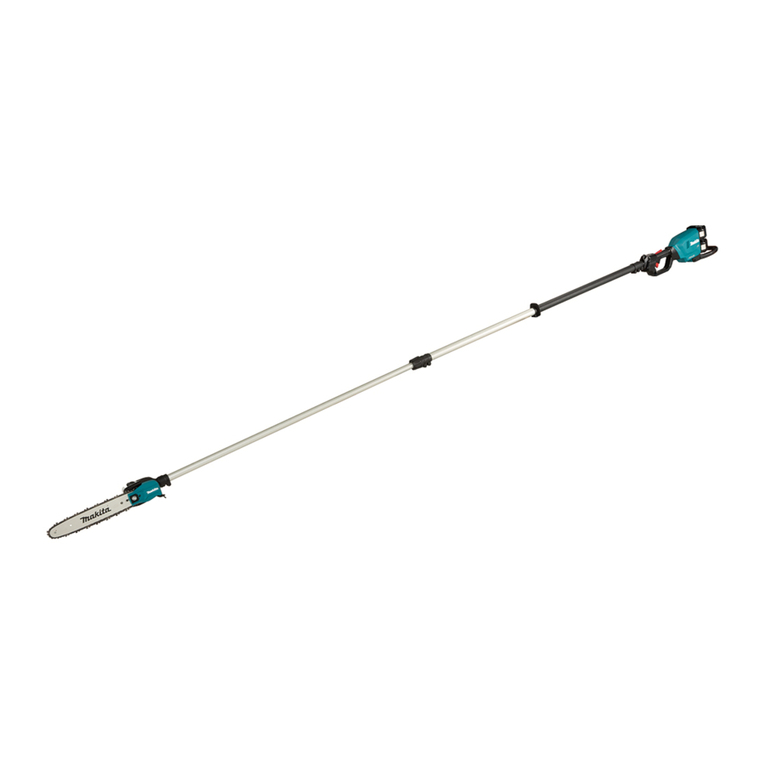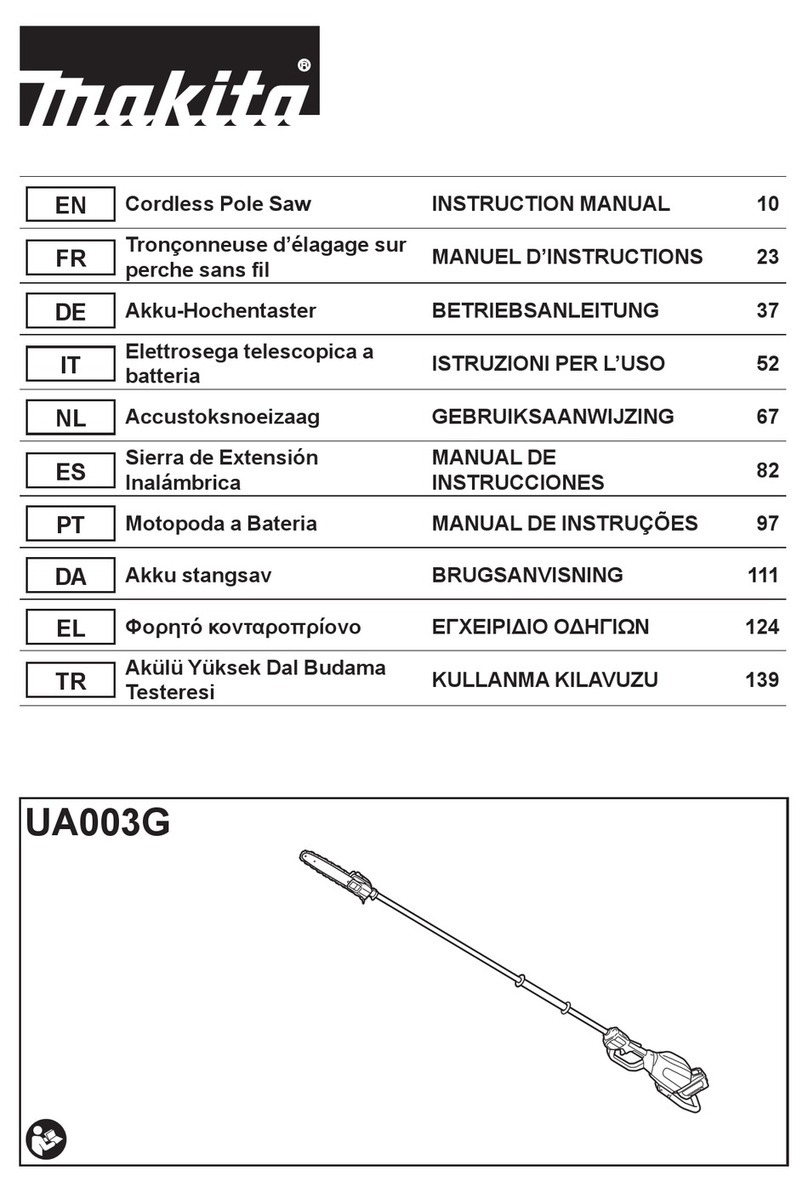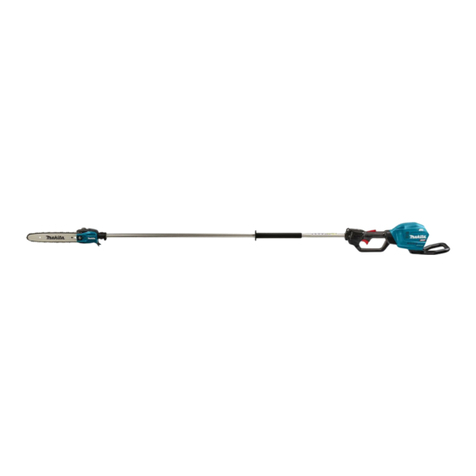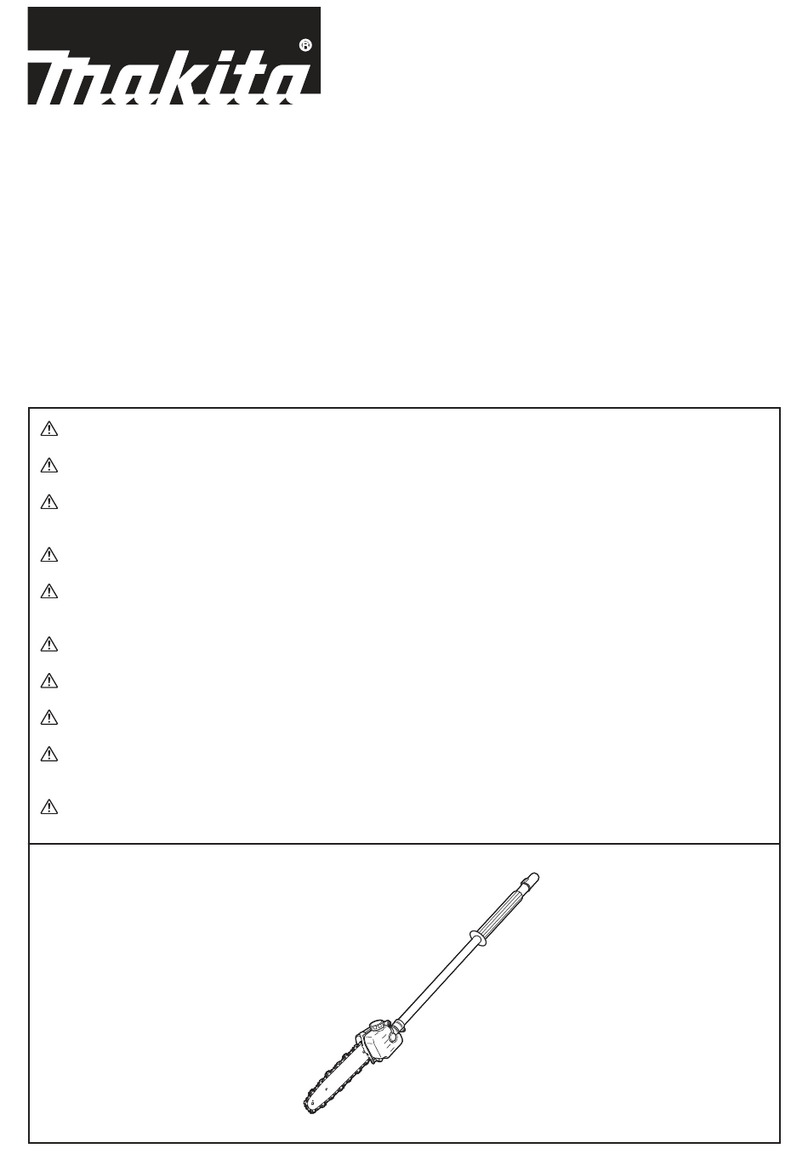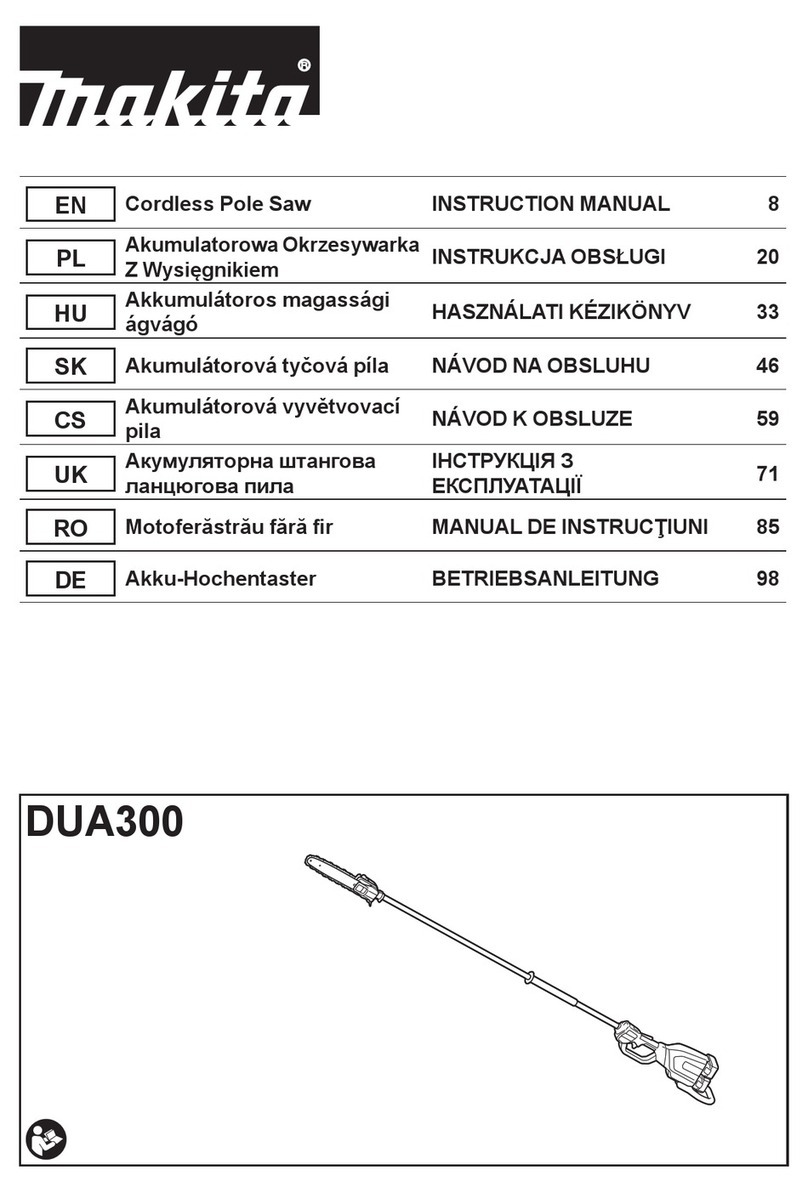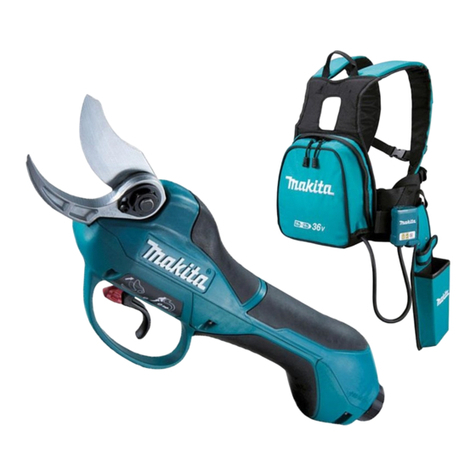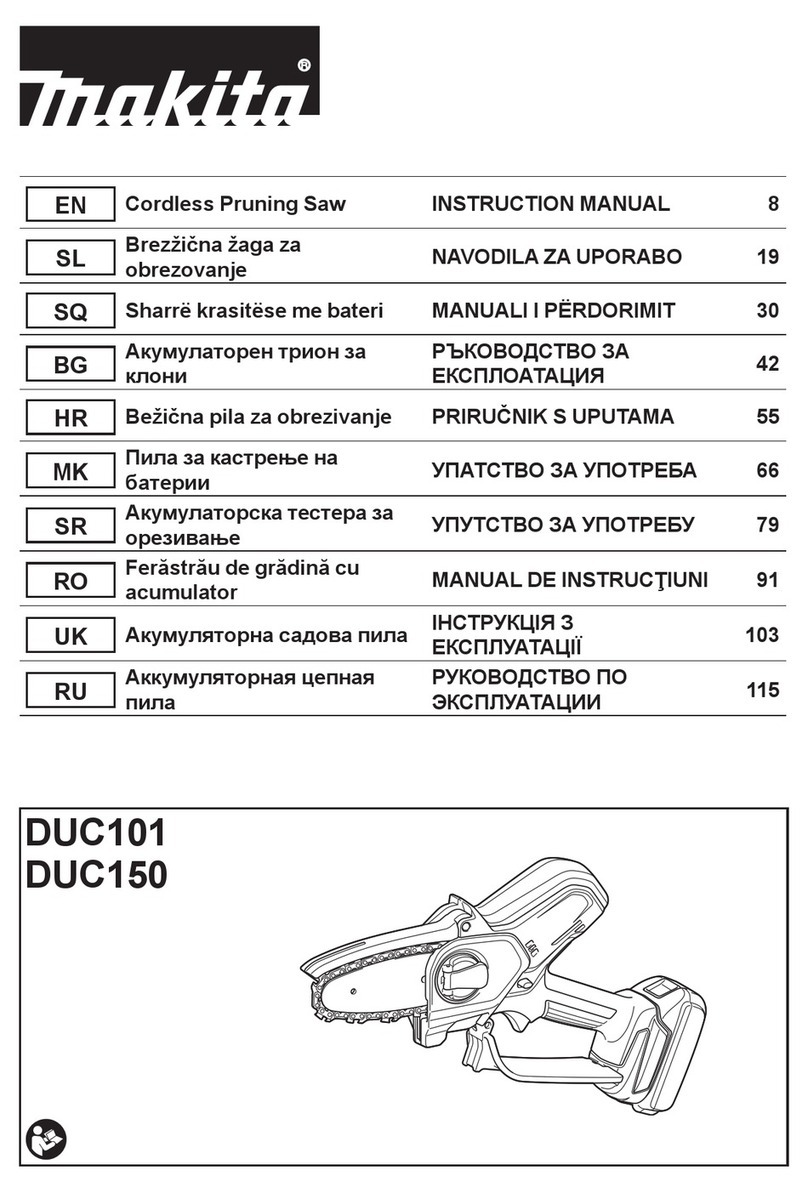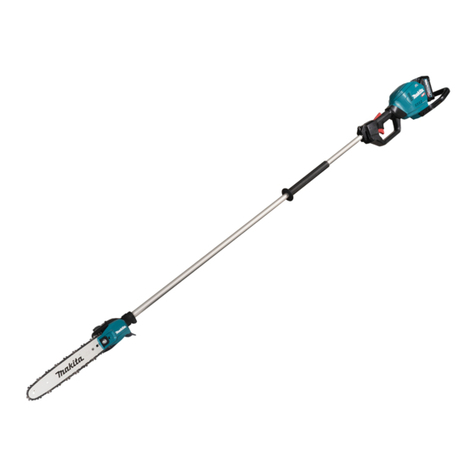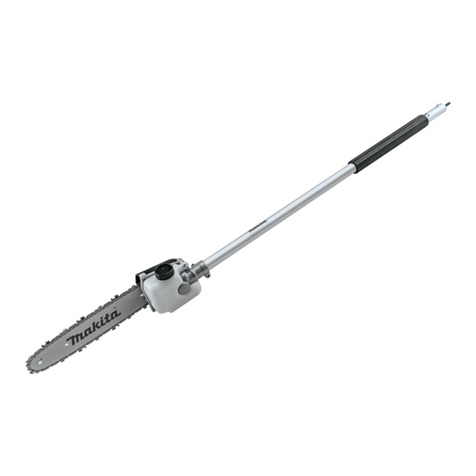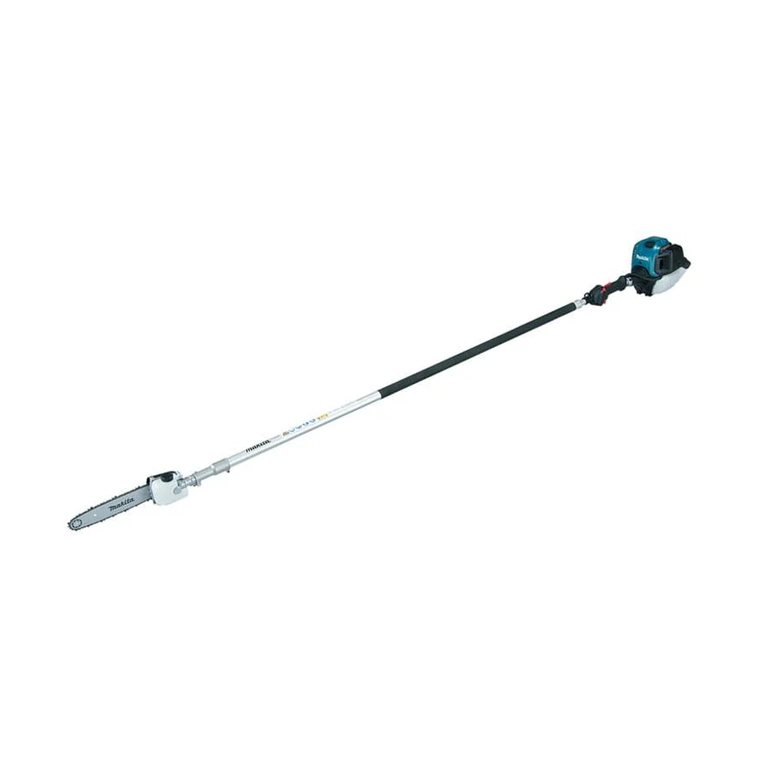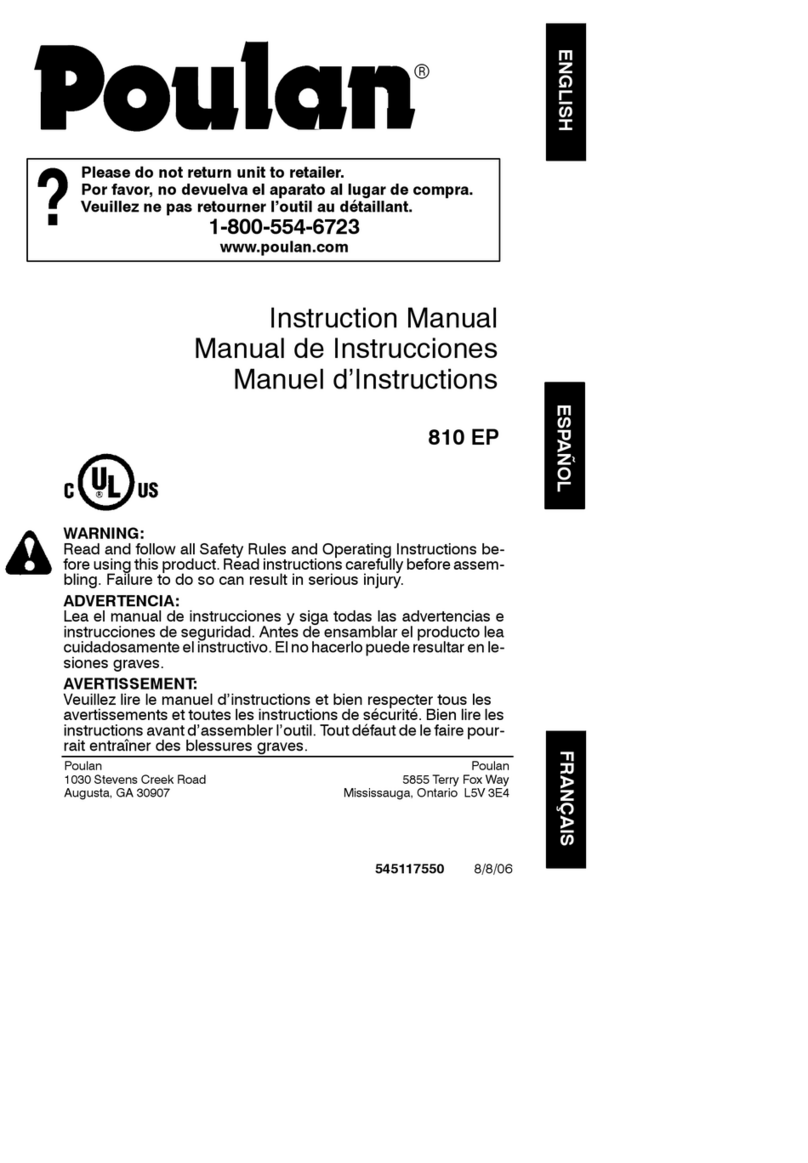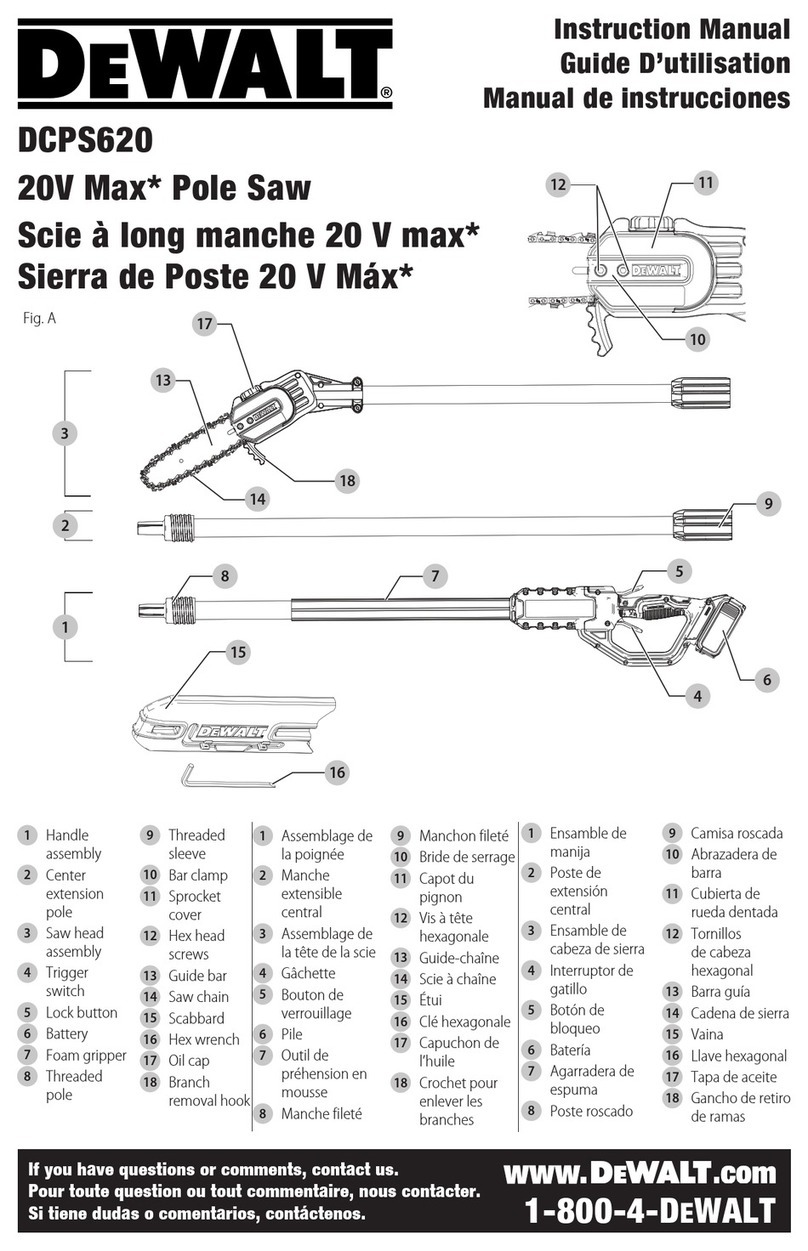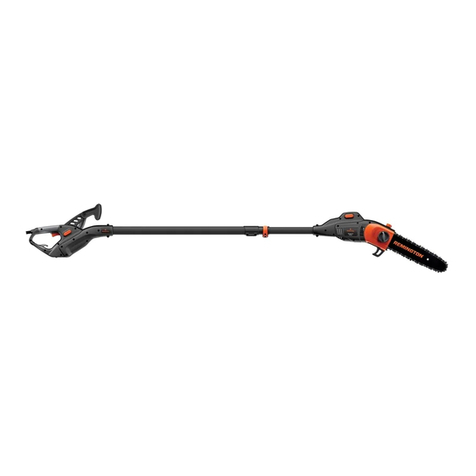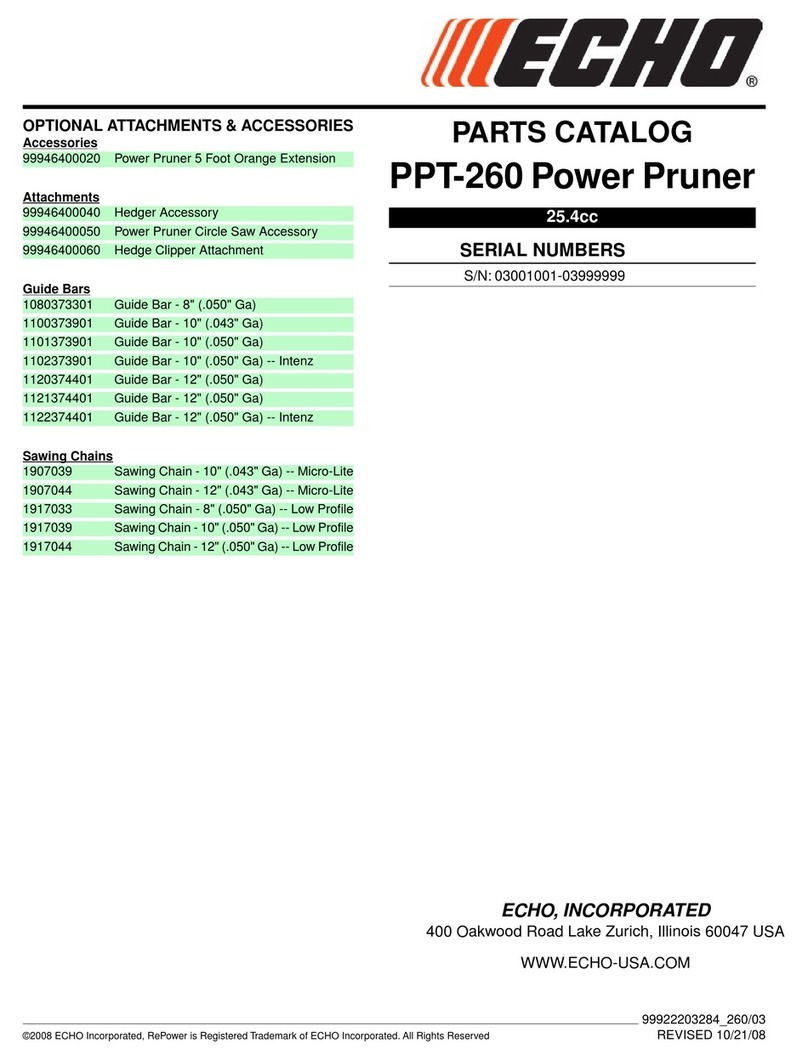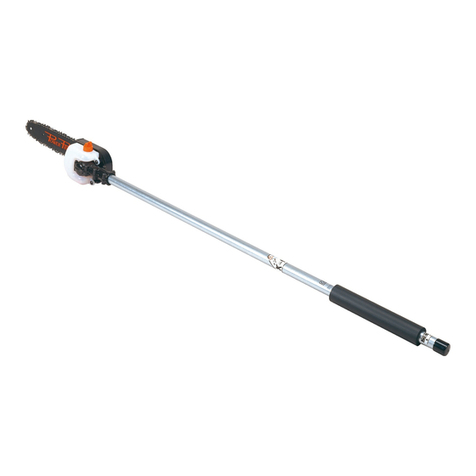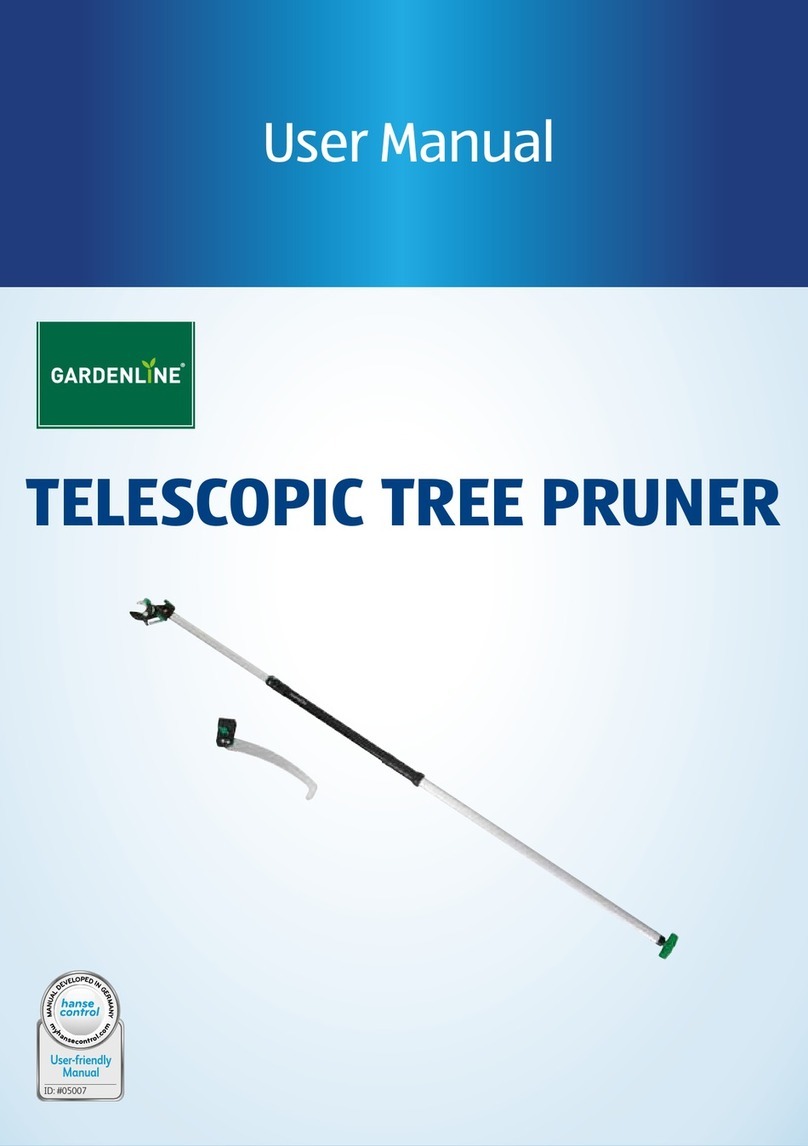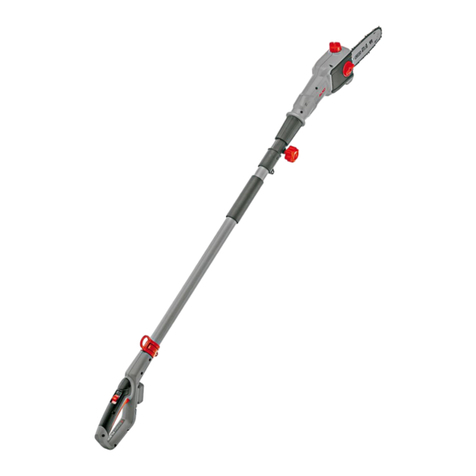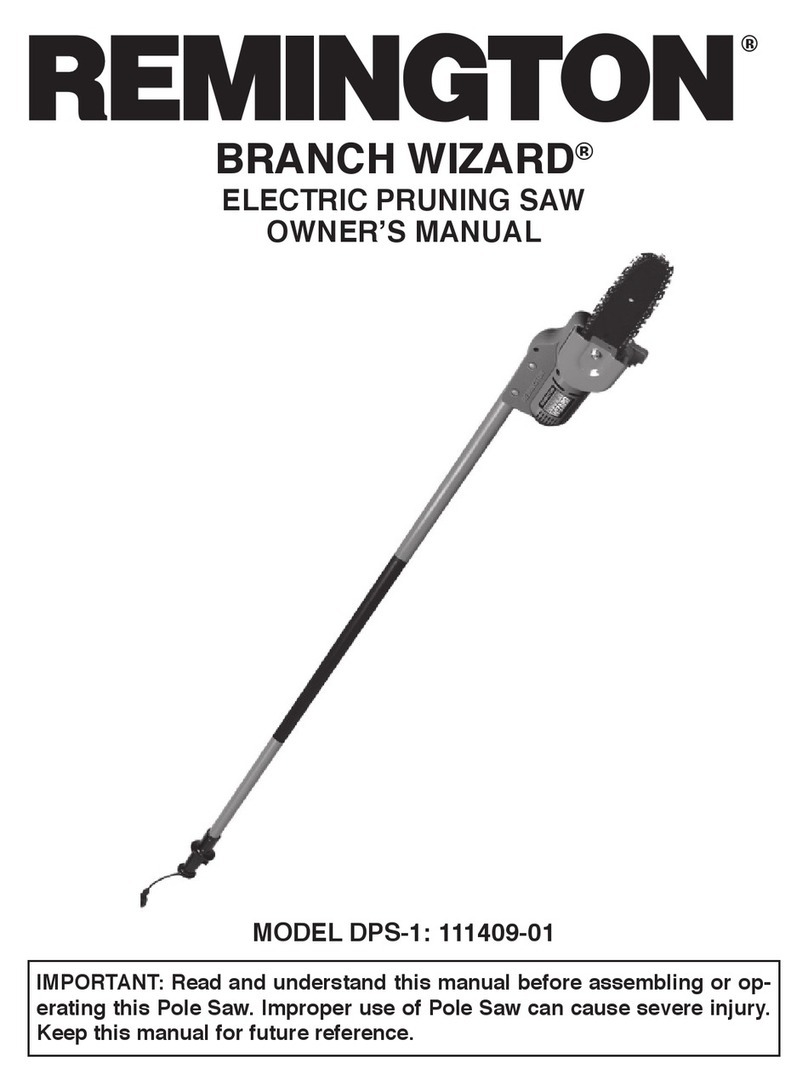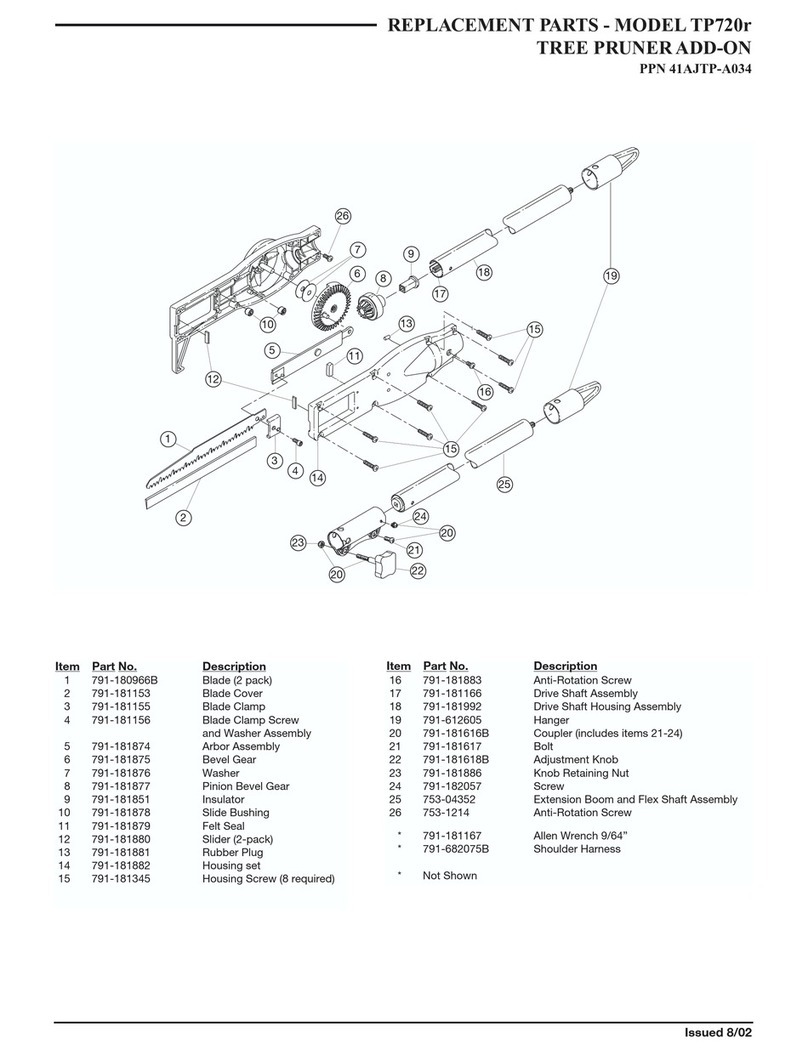
10 ENGLISH
General pruner saw safety warnings
1. Keep all parts of the body away from the
saw chain when the pruner saw is operating.
Before you start the pruner saw, make sure
the saw chain is not contacting anything. A
m o m e n t o f i n a t t e n t i o n w h i l e o p e r a t i n g p r u n e r s a w s
m a y c a u s e e n t a n g l e m e n t o f y o u r c l o t h i n g o r b o d y
w i t h t h e s a w c h a i n .
2. Always hold the pruner saw with one hand
on the rear handle and the other hand on the
auxiliary handle.
3. Hold the pruner saw by insulated gripping
surfaces only, because the saw chain may con-
tact hidden wiring. S a w c h a i n s c o n t a c t i n g a " l i v e "
w i r e m a y m a k e e x p o s e d m e t a l p a r t s o f t h e p r u n e r
s a w " l i v e " a n d c o u l d g i v e t h e o p e r a t o r a n e l e c t r i c
s h o c k .
4 . Wear eye protection. Further protective equip-
ment for hearing, head, hands, legs and feet is
recommended. A d e q u a t e p r o t e c t i v e e q u i p m e n t
will reduce personal injury from ying debris or
a c c i d e n t a l c o n t a c t w i t h t h e s a w c h a i n .
5. Do not operate a pruner saw in a tree, on a lad-
der, from a rooftop, or any unstable support.
O p e r a t i o n o f a p r u n e r s a w i n t h i s m a n n e r c o u l d
result in serious personal injury.
6 . Always keep proper footing and operate the
pruner saw only when standing on xed,
secure and level surface. S l i p p e r y o r u n s t a b l e
s u r f a c e s m a y c a u s e a l o s s o f b a l a n c e o r c o n t r o l o f
t h e p r u n e r s a w .
7 . When cutting a branch that is under tension,
be alert for spring back. W h e n t h e t e n s i o n i n t h e
wood bres is released, the spring loaded branch
m a y s t r i k e t h e o p e r a t o r a n d / o r t h r o w t h e p r u n e r
s a w o u t o f c o n t r o l .
8. Use extreme caution when cutting brush and
saplings. T h e s l e n d e r m a t e r i a l m a y c a t c h t h e s a w
chain and be whipped toward you or pull you o
balance.
9. Carry the pruner saw with the pruner saw
switched o and away from your body. When
transporting or storing the pruner saw, always
t the guide bar cover. P r o p e r h a n d l i n g o f t h e
p r u n e r s a w w i l l r e d u c e t h e l i k e l i h o o d o f a c c i d e n t a l
c o n t a c t w i t h t h e m o v i n g s a w c h a i n .
10. Follow instructions for lubricating, chain
tensioning and changing the bar and chain.
Im p r o p e r l y t e n s i o n e d o r l u b r i c a t e d c h a i n m a y
e i t h e r b r e a k o r i n c r e a s e t h e c h a n c e f o r k i c k b a c k .
11. Cut wood only. Do not use pruner saw for pur-
poses not intended. For example: do not use
pruner saw for cutting metal, plastic, masonry
or non-wood building materials. U s e o f t h e
pruner saw for operations dierent than intended
c o u l d r e s u l t i n a h a z a r d o u s s i t u a t i o n .
12. This pruner saw is not intended for tree felling.
Use of the pruner saw for operations dierent than
intended could result in serious injury to the opera-
t o r o r b y s t a n d e r s .
13. Follow all instructions when clearing jammed
material, storing or servicing the pruner saw.
Make sure the switch is o and the battery
pack is removed.
14 . Causes and operator prevention of kickback:
K i c k b a c k m a y o c c u r w h e n t h e n o s e o r t i p o f t h e
guide bar touches an object, or when the wood
c l o s e s i n a n d p i n c h e s t h e s a w c h a i n i n t h e c u t .
T i p c o n t a c t i n s o m e c a s e s m a y c a u s e a s u d d e n
r e v e r s e r e a c t i o n , k i c k i n g t h e g u i d e b a r u p a n d
b a c k t o w a r d s t h e o p e r a t o r .
P i n c h i n g t h e s a w c h a i n a l o n g t h e t o p o f t h e g u i d e
b a r m a y p u s h t h e g u i d e b a r r a p i d l y b a c k t o w a r d s
t h e o p e r a t o r .
Ei t h e r o f t h e s e r e a c t i o n s m a y c a u s e y o u t o l o s e
c o n t r o l o f t h e s a w w h i c h c o u l d r e s u l t i n s e r i o u s
personal injury. Do not rely exclusively upon the
s a f e t y d e v i c e s b u i l t i n t o y o u r s a w . A s a p r u n e r s a w
u s e r , y o u s h o u l d t a k e s e v e r a l s t e p s t o k e e p y o u r
cutting jobs free from accident or injury.
K i c k b a c k i s t h e r e s u l t o f p r u n e r s a w m i s u s e a n d / o r
i n c o r r e c t o p e r a t i n g p r o c e d u r e s o r c o n d i t i o n s a n d
c a n b e a v o i d e d b y t a k i n g p r o p e r p r e c a u t i o n s a s
g i v e n b e l o w :
•Maintain a rm grip, with thumbs and n-
gers encircling the pruner saw handles,
with both hands on the saw and position
your body and arm to allow you to resist
kickback forces. K i c k b a c k f o r c e s c a n b e
c o n t r o l l e d b y t h e o p e r a t o r , i f p r o p e r p r e c a u -
t i o n s a r e t a k e n . Do n o t l e t g o o f t h e p r u n e r
s a w .
Fig.1
•Do not overreach and do not cut above
shoulder height. T h i s h e l p s p r e v e n t u n i n -
t e n d e d t i p c o n t a c t a n d e n a b l e s b e t t e r c o n t r o l
o f t h e p r u n e r s a w i n u n e x p e c t e d s i t u a t i o n s .
•Only use replacement guide bars and saw
chains specied by the manufacturer.
In c o r r e c t r e p l a c e m e n t g u i d e b a r s a n d s a w
c h a i n s m a y c a u s e c h a i n b r e a k a g e a n d / o r
k i c k b a c k .
•Follow the manufacturer’s sharpening
and maintenance instructions for the saw
chain. De c r e a s i n g t h e d e p t h g a u g e h e i g h t
c a n l e a d t o i n c r e a s e d k i c k b a c k .
15. Follow all instructions when clearing jammed
material, storing or servicing the pruner saw.
Make sure the switch is o and the battery
pack is removed.
Additional Safety Instructions
Personal protective equipment
1. Clothing must be close-tting, but must not
obstruct mobility.
2. Wear the following protective clothing during
work:
•A t e s t e d s a f e t y h e l m e t , i f a h a z a r d i s p r e -
s e n t e d b y f a l l i n g b r a n c h e s o r s i m i l a r ;
•A f a c e m a s k o r g o g g l e s ;
Suitable ear protection (ear mus, custom or
m o u l d a b l e e a r p l u g s ) . O c t a v e b r a n d a n a l y s i s
upon request.
•F i r m l e a t h e r s a f e t y g l o v e s ;
•L o n g t r o u s e r s m a n u f a c t u r e d f r o m s t r o n g
f a b r i c ;
•P r o t e c t i v e d u n g a r e e s o f c u t -r e s i s t a n t f a b r i c ;
